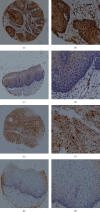Clinicopathological Significance of AKT1 and PLK1 Expression in Oral Squamous Cell Carcinoma
- PMID: 35756492
- PMCID: PMC9232379
- DOI: 10.1155/2022/7300593
Clinicopathological Significance of AKT1 and PLK1 Expression in Oral Squamous Cell Carcinoma
Abstract
Purpose: Oral squamous cell carcinoma (OSCC) is the sixth leading cause of cancer-related death worldwide and is characterized by metastasis and recurrence. We aimed to evaluate the expression of AKT1 and PLK1 in OSCC and identify their correlation with the clinical and histological features and prognosis of patients with OSCC.
Methods: Tissue samples were collected from 70 patients with OSCC and 50 patients with normal oral mucosa. The expression levels of AKT1 and PLK1 in OSCC tissues and normal oral mucosa were detected by immunohistochemistry. The chi-square test was used to identify correlations between the expression levels of AKT1 and PLK1 with patients' clinicopathologic characteristics. Survival analysis was assessed by the Kaplan-Meier method. Spearman's rank correlation test was used to determine the relationships between AKT1 and PLK1 expressions. The bioinformatics database GEPIA was used to verify the experimental results.
Results: The chi-square test and Fisher's exact test showed that the positive expression rate of AKT1 and PLK1 in OSCC tissue was significantly higher than that in the normal oral mucosa (P < 0.05). PLK1 expression levels were significantly correlated with tumor stage and size (P < 0.05). Kaplan-Meier analysis showed that the survival time of AKT1 and PLK1 with high expression was significantly shorter than that of patients with low expression (P < 0.05). Spearman's rank correlation test showed a strong correlation between AKT1 and PLK1 expression in OSCC tissue (R = 0.53; P < 0.05). GEPIA bioinformatics database analysis results show that the expression and overall survival of AKT1 and PLK1 analysis and the correlation analysis of AKT1 and PLK1 were consistent with experimental results.
Conclusion: AKT1 and PLK1 expressions are associated with the occurrence and progression of OSCC and may be used as diagnostic and prognostic indicators of OSCC. There may be a correlation between AKT1 and PLK1 in OSCC tissue.
Copyright © 2022 Er-Can Sun et al.
Conflict of interest statement
The authors report no conflicts of interest in this work.
Figures




Similar articles
-
Immunohistochemical expression of polo-like kinase 1 in oral squamous cell carcinoma and oral submucous fibrosis.Indian J Dent Res. 2018 Mar-Apr;29(2):171-175. doi: 10.4103/ijdr.IJDR_59_17. Indian J Dent Res. 2018. PMID: 29652009
-
ER maleate is a novel anticancer agent in oral cancer: implications for cancer therapy.Oncotarget. 2016 Mar 29;7(13):17162-81. doi: 10.18632/oncotarget.7751. Oncotarget. 2016. PMID: 26934445 Free PMC article.
-
In silico drug design and molecular docking studies targeting Akt1 (RAC-alpha serine/threonine-protein kinase) and Akt2 (RAC-beta serine/threonine-protein kinase) proteins and investigation of CYP (cytochrome P450) inhibitors against MAOB (monoamine oxidase B) for OSCC (oral squamous cell carcinoma) treatment.J Biomol Struct Dyn. 2021 Oct;39(17):6467-6479. doi: 10.1080/07391102.2020.1802335. Epub 2020 Aug 4. J Biomol Struct Dyn. 2021. PMID: 32746771
-
Clinicopathological and prognostic implications of polo-like kinase 1 expression in colorectal cancer: A systematic review and meta-analysis.Gene. 2019 Dec 30;721:144097. doi: 10.1016/j.gene.2019.144097. Epub 2019 Sep 4. Gene. 2019. PMID: 31493507
-
Comprehensive analysis of PLKs expression and prognosis in breast cancer.Cancer Genet. 2022 Nov;268-269:83-92. doi: 10.1016/j.cancergen.2022.09.007. Epub 2022 Sep 26. Cancer Genet. 2022. PMID: 36206661 Review.
Cited by
-
CIP2A interacts with AKT1 to promote the malignant biological behaviors of oral squamous cell carcinoma by upregulating the GSK‑3β/β‑catenin pathway.Exp Ther Med. 2023 Sep 20;26(5):514. doi: 10.3892/etm.2023.12213. eCollection 2023 Nov. Exp Ther Med. 2023. PMID: 37840566 Free PMC article.
-
MicroRNA-Based Markers of Oral Tongue Squamous Cell Carcinoma and Buccal Squamous Cell Carcinoma: A Systems Biology Approach.Biochem Res Int. 2023 Apr 24;2023:5512894. doi: 10.1155/2023/5512894. eCollection 2023. Biochem Res Int. 2023. PMID: 37143570 Free PMC article.
-
Longikaurin A, a natural ent-kaurane, suppresses proliferation, invasion and tumorigenicity in oral squamous cell carcinoma cell by via inhibiting PI3K/Akt pathway in vitro and in vivo.J Cancer. 2025 Jan 1;16(3):708-719. doi: 10.7150/jca.102125. eCollection 2025. J Cancer. 2025. PMID: 39781358 Free PMC article.
-
Exploring the role of PANoptosis related genes in the prognosis of oral squamous cell carcinoma subtypes based on multi-omics analysis.Discov Oncol. 2025 Jul 11;16(1):1305. doi: 10.1007/s12672-025-03154-2. Discov Oncol. 2025. PMID: 40643861 Free PMC article.
-
The Multiple Roles of CD147 in the Development and Progression of Oral Squamous Cell Carcinoma: An Overview.Int J Mol Sci. 2022 Jul 28;23(15):8336. doi: 10.3390/ijms23158336. Int J Mol Sci. 2022. PMID: 35955471 Free PMC article. Review.
References
MeSH terms
Substances
LinkOut - more resources
Full Text Sources
Medical
Miscellaneous

